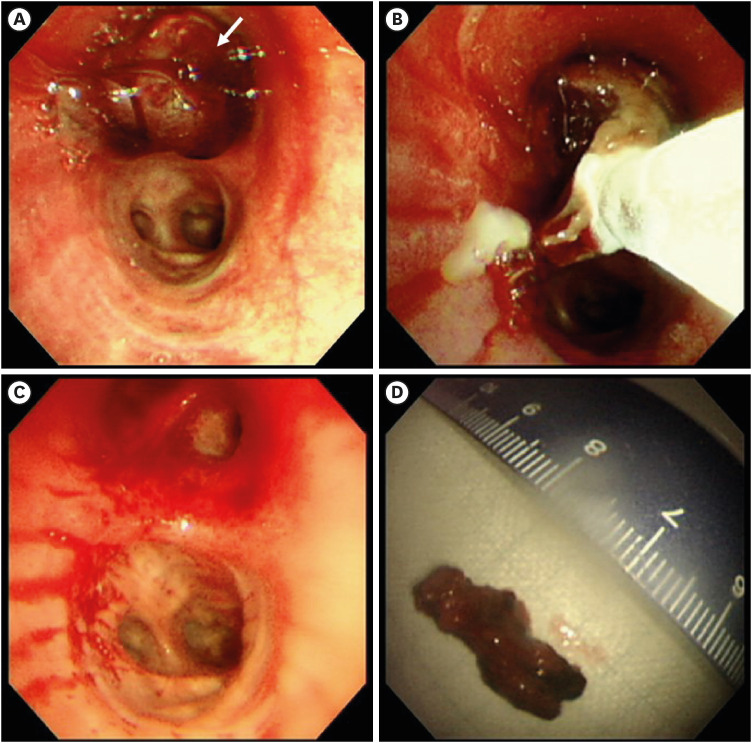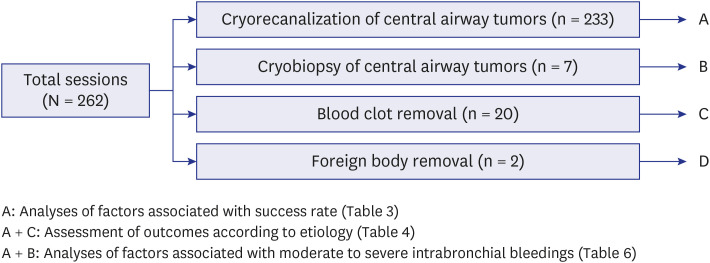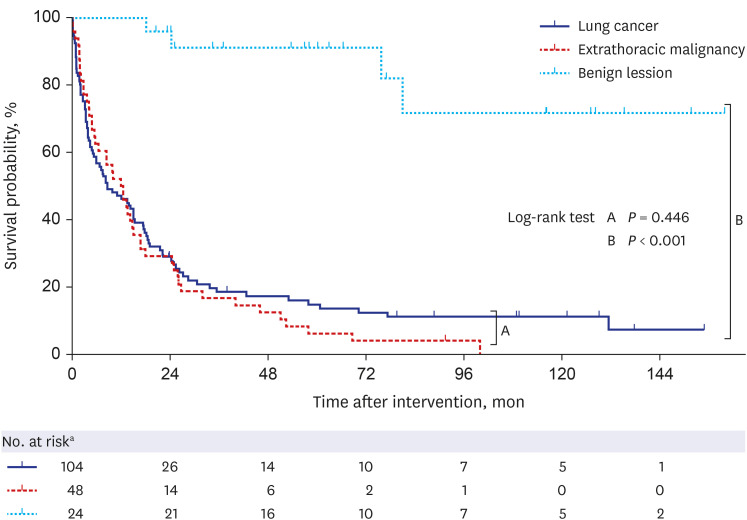J Korean Med Sci.
2023 Aug;38(32):e244. 10.3346/jkms.2023.38.e244.
Clinical Outcomes of Bronchoscopic Cryotherapy for Central Airway Obstruction in Adults: An 11-Years’ Experience of a Single Center
- Affiliations
-
- 1Department of Pulmonary and Critical Care Medicine, Asan Medical Center, University of Ulsan College of Medicine, Seoul, Korea
- 2Division of Pulmonology and Allergy, Department of Internal Medicine, Gyeongsang National University Hospital, Gyeongsang National University School of Medicine, Jinju, Korea
- KMID: 2545196
- DOI: http://doi.org/10.3346/jkms.2023.38.e244
Abstract
- Background
Although bronchoscopic cryotherapy (BC) is a pragmatic modality for recanalization of central airway obstruction (CAO), the risk of complications, such as bleeding, remains a concern. This study aimed to present the clinical outcomes of BC and evaluate the factors associated with its complications.
Methods
In this retrospective study, we reviewed the medical records of patients who underwent BC for CAO at the Asan Medical Center, South Korea. Most sessions were conducted via flexible bronchoscopy under moderate sedation. A multivariate logistic regression analysis was used to identify the factors associated with the success rate and complications.
Results
BC was performed in 262 sessions in 208 patients between January 2009 and December 2020. The most common cause of cryotherapy was recanalization of the endobronchial tumor related CAO (233/262, 88.9%). More than partial re-establishment of airway patency was achieved in 211 of 233 (90.6%) sessions. The success rate did not differ significantly in the multivariate logistic regression analysis. The most common complication was intrabronchial bleeding (78/233, 35.5%); however, severe bleeding occurred only in one case (0.4%). Univariate and multivariate logistic regression analyses revealed that diabetes mellitus (odds ratio [OR] = 2.820, P = 0.011), respiratory failure before BC (OR = 3.546, P = 0.028), and presence of distal airway atelectasis (OR = 0.417, P = 0.021) were independently associated with moderate to severe intrabronchial bleeding, while the histologic type of tumor was not related to bleeding. BC for CAO caused by blood clot or foreign body was successful in most cases, and there were no complications.
Conclusion
BC is an efficient and relatively safe intervention for patients with CAO. Our findings suggest that diabetes, respiratory failure before BC, and the absence of distal airway atelectasis may be risk factors of moderate to severe intrabronchial bleeding.
Figure
Reference
-
1. Ernst A, Feller-Kopman D, Becker HD, Mehta AC. Central airway obstruction. Am J Respir Crit Care Med. 2004; 169(12):1278–1297. PMID: 15187010.2. Chin CS, Litle V, Yun J, Weiser T, Swanson SJ. Airway stents. Ann Thorac Surg. 2008; 85(2):S792–S796. PMID: 18222219.3. Stöhr S, Bolliger CT. Stents in the management of malignant airway obstruction. Monaldi Arch Chest Dis. 1999; 54(3):264–268. PMID: 10441984.4. Mitchell PD, Kennedy MP. Bronchoscopic management of malignant airway obstruction. Adv Ther. 2014; 31(5):512–538. PMID: 24849167.5. Hollingsworth HM. Wheezing and stridor. Clin Chest Med. 1987; 8(2):231–240. PMID: 3304813.6. Noppen M, Meysman M, D’Haese J, Schlesser M, Vincken W. Interventional bronchoscopy: 5-year experience at the Academic Hospital of the Vrije Universiteit Brussel (AZ-VUB). Acta Clin Belg. 1997; 52(6):371–380. PMID: 9489133.7. Gorden JA, Ernst A. Endoscopic management of central airway obstruction. Semin Thorac Cardiovasc Surg. 2009; 21(3):263–273. PMID: 19942126.8. Mathur PN, Wolf KM, Busk MF, Briete WM, Datzman M. Fiberoptic bronchoscopic cryotherapy in the management of tracheobronchial obstruction. Chest. 1996; 110(3):718–723. PMID: 8797417.9. Bolliger CT, Mathur PN, Beamis JF, Becker HD, Cavaliere S, Colt H, et al. ERS/ATS statement on interventional pulmonology. Eur Respir J. 2002; 19(2):356–373. PMID: 11866017.10. Hetzel M, Hetzel J, Schumann C, Marx N, Babiak A. Cryorecanalization: a new approach for the immediate management of acute airway obstruction. J Thorac Cardiovasc Surg. 2004; 127(5):1427–1431. PMID: 15116003.11. Yilmaz A, Aktaş Z, Alici IO, Cağlar A, Sazak H, Ulus F. Cryorecanalization: keys to success. Surg Endosc. 2012; 26(10):2969–2974. PMID: 22609980.12. Schumann C, Hetzel M, Babiak AJ, Hetzel J, Merk T, Wibmer T, et al. Endobronchial tumor debulking with a flexible cryoprobe for immediate treatment of malignant stenosis. J Thorac Cardiovasc Surg. 2010; 139(4):997–1000. PMID: 19716140.13. Inaty H, Folch E, Berger R, Fernandez-Bussy S, Chatterji S, Alape D, et al. Unimodality and multimodality cryodebridement for airway obstruction. a single-center experience with safety and efficacy. Ann Am Thorac Soc. 2016; 13(6):856–861. PMID: 26999041.14. DiBardino DM, Lanfranco AR, Haas AR. Bronchoscopic cryotherapy. clinical applications of the cryoprobe, cryospray, and cryoadhesion. Ann Am Thorac Soc. 2016; 13(8):1405–1415. PMID: 27268274.15. Chung FT, Chou CL, Lo YL, Kuo CH, Wang TY, Wang CH, et al. Factors affecting survival in patients with endobronchial malignant mass after flexible bronchoscopic cryotherapy: a cohort study. BMC Pulm Med. 2019; 19(1):101. PMID: 31126271.16. Sriratanaviriyakul N, Lam F, Morrissey BM, Stollenwerk N, Schivo M, Yoneda KY. Safety and clinical utility of flexible bronchoscopic cryoextraction in patients with non-neoplasm tracheobronchial obstruction: a retrospective chart review. J Bronchology Interv Pulmonol. 2015; 22(4):288–293. PMID: 26439016.17. Heald AH, Stedman M, Davies M, Livingston M, Alshames R, Lunt M, et al. Estimating life years lost to diabetes: outcomes from analysis of National Diabetes Audit and Office of National Statistics data. Cardiovasc Endocrinol Metab. 2020; 9(4):183–185. PMID: 33225235.18. Rydén L, Standl E, Bartnik M, Van den Berghe G, Betteridge J, de Boer MJ, et al. Guidelines on diabetes, pre-diabetes, and cardiovascular diseases: executive summary. Eur Heart J. 2007; 28(1):88–136. PMID: 17220161.19. King S, Klineberg I, Levinger I, Brennan-Speranza TC. The effect of hyperglycaemia on osseointegration: a review of animal models of diabetes mellitus and titanium implant placement. Arch Osteoporos. 2016; 11(1):29. PMID: 27637755.20. Flyvbjerg A. Diabetic angiopathy, the complement system and the tumor necrosis factor superfamily. Nat Rev Endocrinol. 2010; 6(2):94–101. PMID: 20098449.21. Dunham-Snary KJ, Wu D, Sykes EA, Thakrar A, Parlow LR, Mewburn JD, et al. Hypoxic pulmonary vasoconstriction: from molecular mechanisms to medicine. Chest. 2017; 151(1):181–192. PMID: 27645688.22. Akoglu S, Uçan ES, Celik G, Sener G, Sevinç C, Kilinç O, et al. Endobronchial metastases from extrathoracic malignancies. Clin Exp Metastasis. 2005; 22(7):587–591. PMID: 16475029.23. Tsuboi R, Oki M, Saka H, Kogure Y, Oka S, Nakahata M, et al. Rigid bronchoscopic intervention for endobronchial metastasis of renal cell carcinoma. Respir Investig. 2016; 54(4):250–254.24. Suyama H, Igishi T, Makino H, Kaminou T, Hashimoto M, Sumikawa T, et al. Bronchial artery embolization before interventional bronchoscopy to avoid uncontrollable bleeding: a case report of endobronchial metastasis of renal cell carcinoma. Intern Med. 2011; 50(2):135–139. PMID: 21245638.25. Tao M, Zhang N, Wang H, Ma H, Gao H, Wang Z. Bronchial arterial embolization may reduce the risk of severe bleeding in central airway obstruction due to renal cell carcinomas during bronchoscopic procedures. Ther Adv Respir Dis. 2020; 14:1753466620976012. PMID: 33272105.
- Full Text Links
- Actions
-
Cited
- CITED
-
- Close
- Share
- Similar articles
-
- Bronchoscopic Cryotherapy in Patients with Central Airway Obstruction
- Two Cases of Central Airway Obstruction Treated with an Insulation-Tipped Diathermic Knife-2
- Two Cases of Diagnosis and Removal of Endobronchial Hamartoma by Cryotherapy via Flexible Bronchoscopy
- Clinical Benefits and Complications of Cryotherapy in Advanced Lung Cancer with Central Airway Obstruction
- Successful Removal of Endobronchial Blood Clots Using Bronchoscopic Cryotherapy at Bedside in the Intensive Care Unit




